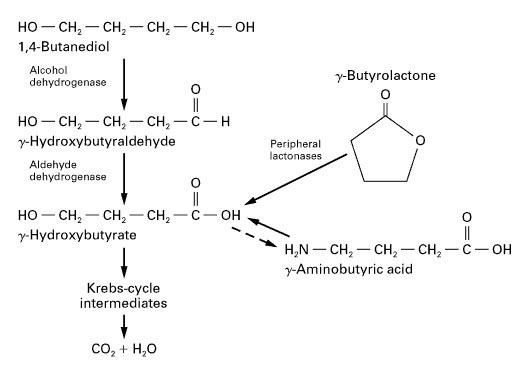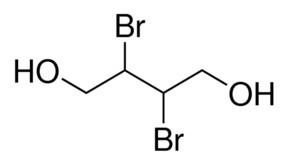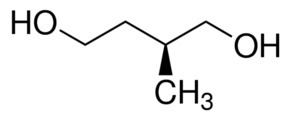Formula C4H10O2 | Density 1.02 g/cm³ | |
 | ||
Related compounds Similar Polytetrahydrofuran, Isobutanol, Tetrahydrofuran CAS Number 110-63-4 ChEBI CHEBI:41189 ChEMBL ChEMBL171623 ChemSpider 13835209 DrugBank DB01955 ECHA InfoCard 100.003.443 EC Number 203-786-5 PubChem CID 8064 RTECS number EK0525000 UNII 7XOO2LE6G3 Melting point 20.1 °C (68.2 °F; 293.2 K) Boiling point 235 °C (455 °F; 508 K) Solubility in water Miscible Magnetic susceptibility (χ) -61.5·10−6 cm3/mol Refractive index (nD) Refractive index (nD) | ||
1,4-Butanediol, colloquially known as BD, is the organic compound with the formula HOCH2CH2CH2CH2OH. This colorless viscous liquid is derived from butane by placement of alcohol groups at each end of the chain. It is one of many stable isomers of butanediol.
Contents
- Global and china 1 4 butanediol bdo industry report 2014 2017
- Synthesis
- Industrial use
- Health effects and use as a drug
- Pharmacokinetics
- Pharmacodynamics
- Legality
- 2007 contamination of Bindeez toy
- References

Global and china 1 4 butanediol bdo industry report 2014 2017
Synthesis

In its industrial synthesis, acetylene reacts with two equivalents of formaldehyde to form 1,4-butynediol. This type of acetylene-based process is illustrative of what is known as "Reppe chemistry", after German chemist Walter Reppe. Hydrogenation of 1,4-butynediol gives 1,4-butanediol. This route is used by BASF and Ashland/ISP.

LyondellBasell manufactures 1,4-butanediol in a multi-step process without the use of acetylene. First, propylene oxide is converted to allyl alcohol. The allyl alcohol is then hydroformylated to 4-hydroxybutyraldehyde. Hydrogenation of this aldehyde yields 1,4-butanediol.

It is also manufactured on an industrial scale from maleic anhydride in the Davy process, which is first converted to the methyl maleate ester, then hydrogenated. Other routes are from butadiene, allyl acetate and succinic acid.

A biological route to BDO has been commerciallized that uses a genetically modified organism. The biosynthesis proceeds via 4-hydroxybutyrate.
Industrial use

1,4-Butanediol is used industrially as a solvent and in the manufacture of some types of plastics, elastic fibers and polyurethanes. In organic chemistry, 1,4-butanediol is used for the synthesis of γ-butyrolactone (GBL). In the presence of phosphoric acid and high temperature, it dehydrates to the important solvent tetrahydrofuran. At about 200 °C in the presence of soluble ruthenium catalysts, the diol undergoes dehydrogenation to form butyrolactone.

World production of 1,4-butanediol was claimed to be about one million metric tons per year and market price is about 2,000 USD (1,600 EUR) per ton (2005). In 2013, worldwide production was claimed to be billions of lbs (consistent with approximately one million metric tons).

Almost half of it is dehydrated to tetrahydrofuran to make fibers such as Spandex. The largest producer is BASF.
Health effects and use as a drug

1,4-Butanediol is also used as a recreational drug known by some users as "One Comma Four", "Liquid Fantasy", "One Four Bee" or "One Four B-D-O". It exerts effects similar to γ-hydroxybutyrate (GHB), which is a metabolic product of 1,4-butanediol. When mixed with other drugs, misuse of 1,4-butanediol has resulted in addiction and death.
Pharmacokinetics
1,4-Butanediol is converted into GHB by the enzymes alcohol dehydrogenase and aldehyde dehydrogenase and differing levels of these enzymes may account for differences in effects and side effects between users. While co-administration of ethanol and GHB already poses serious risks, co-administration of ethanol with 1,4-butanediol will interact considerably and has many other potential risks. This is because the same enzymes that are responsible for metabolizing alcohol also metabolize 1,4-butanediol so there is a strong chance of a dangerous drug interaction. Emergency room patients who overdose on both ethanol and 1,4-butanediol often present with symptoms of alcohol intoxication initially and as the ethanol is metabolized the 1,4-butanediol is then able to better compete for the enzyme and a second period of intoxication ensues as the 1,4-butanediol is converted into GHB.
Pharmacodynamics
1,4-Butanediol seems to have two types of pharmacological actions. The major psychoactive effects of 1,4-butanediol are because it is metabolized into GHB; however there is a study suggesting that 1,4-butanediol may have potential alcohol-like pharmacological effects that are not due to this conversion. One should note that the study arrived at this conclusion based on the finding that 1,4-butanediol co-administered with ethanol led to potentiation of some of the behavioral effects of ethanol. However, potentiation of ethanol's effects may simply be caused by competition for the alcohol dehydrogenase and acetaldehyde dehydrogenase enzymes with co-administered 1,4-butanediol. The shared metabolic rate-limiting steps thus leads to slowed metabolism and clearance for both compounds including ethanol's known toxic metabolite acetaldehyde.
Another study found no effect following intracerebroventricular injection in rats of 1,4-butanediol. This contradicts the hypothesis that 1,4-butanediol having inherent alcohol-like pharmacological effects.
Like GHB, 1,4-butanediol is only safe in small amounts. Adverse effects in higher doses include, nausea, vomiting, dizziness, sedation, vertigo, and potentially death if ingested in large amounts. Anxiolytic effects are diminished and side effects increased when used in combination with alcohol.
Legality
While 1,4-butanediol is not currently scheduled federally in the United States - a number of states have classified 1,4-butanediol as a controlled substance. Individuals have been prosecuted for 1,4-butanediol under the Federal analog Act as substantially similar to GHB. A federal case in New York in 2002 ruled that 1,4-butanediol could not be considered an analog of GHB under federal law, but that decision was later overturned by the Second Circuit. However, a Federal District Court in Chicago ruled that 1,4-butanediol could not be considered an analog of GHB under federal law, and the Seventh Circuit Court of Appeals upheld that ruling. In the United Kingdom, 1,4-butanediol was scheduled in December 2009 (along with another GHB precursor, gamma-butyrolactone) as a Class C controlled substance. In Germany, the drug is not explicitly illegal, but might also be treated as illegal if used as a drug. It is controlled as a Schedule VI precursor in Canada.
2007 contamination of Bindeez toy
A toy called "Bindeez" ("Aqua Dots" in North America) was recalled by the distributor in November 2007 because of the presence of 1,4-butanediol. The toy consists of small beads that stick to each other by sprinkling water. 1,4-Butanediol was detected by GC-MS. The production plant seems to have intended to cut costs by replacing less toxic 1,5-pentanediol with 1,4-butanediol. ChemNet China listed the price of 1,4 butanediol at between about US$1,350–2,800 per metric ton, while the price for 1,5-pentanediol is about US$9,700 per metric ton.
